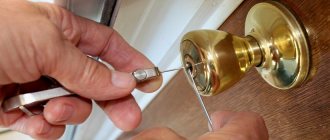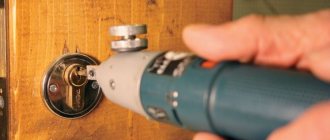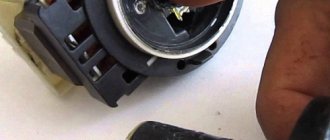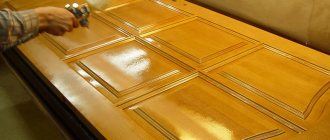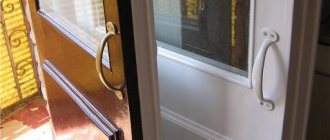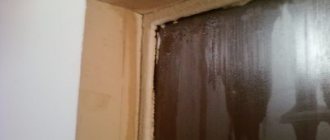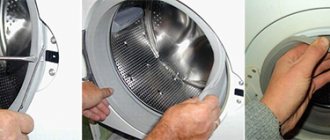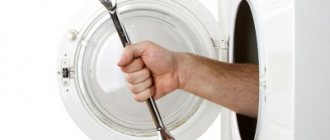Replacing the lock cylinder
Even a simple task, like replacing a lock cylinder on a metal door, will raise a lot of questions for a beginner.
Do I need to completely disassemble the door leaf? Which tool should I use? Is it possible to install a core of another brand in place of the old one? Finally, how to open a jammed front door cylinder? Don't make mistakes! At the first sign of a breakdown, call a repairman. He modernizes the outdated system, carefully installing a new one.
It’s convenient with us:
- We work seven days a week from 8:00 to 23:00;
- cash, non-cash payment;
- take with you a choice of models from different companies.
Replacing the cylinder mechanism
Here we tell you how to replace a lock on a metal door with a cylinder mechanism. Universal instructions will make the work easier even for beginners who have never done anything like this.
What tools will you need?
- crosshead screwdriver,
- slotted screwdriver,
- drill,
- drills of different diameters,
- angle grinder,
- rivet gun, rivets.
How to choose a lock
The parameters of the old locking device will be a guideline. Measure the width, length and depth. Also take into account the backmass, i.e. distance from the end (end plate) to the center of the key hole.
Dismantling the old castle
First we remove the larva. What do you need for this? Unscrew the screw on the end plate. Usually the screw is screwed in under the bolts.
Next, grab the latch from the inside, slowly pull it towards you and turn it. When the lock closes, simply pull out the cylinder. If there is a key hole instead of a latch, you need to insert the key and act in the same way as with the latch.
The second step will be to remove the handles. Unscrew the screws holding them. Under the handle cover you will see a square piece of metal connecting the handles to the locking mechanism. He just pulls out. The housing, which is now secured only at the end, is unscrewed and pulled out.
Then we carefully examine the body, larva, and handles. We select elements that are exactly similar in size: width, length, depth, height. For example, the cylinder should be the same length as the old one so that it does not stick out or fall through the door leaf. The handles are selected according to the length of the bar (no less than the old ones, otherwise there will be holes) and according to the center distance (from the center of the cylinder to the square block).
Installation of a new mechanism
We will carry out the replacement in the reverse order. Those. Let's install the housing first.
Sometimes, even with precise selection of a new mechanism, the holes for attaching the bolts may not match. We need to drill new ones with a drill, only after that we fix the body with rivets. You need to mark a place for attaching the handles. To do this, place a square block and a larva in the hole. Then we “try on” the handles, mark the locations for the holes, and drill. The handle screws are installed from the inside panel of the door, and the caps are installed from the front panel.
We make sure that the key turns first when the door is open, then when the door is closed. If it turns out that the bolt does not fit into the hole, you need to lubricate the area of suspected constipation with toothpaste and repeat. Based on the white mark left by the tongues, you will determine where you need to cut a little space with a grinder.
Most common breakdowns
All work of this kind, including repair of door locks, begins with diagnostics. Steel doors are a constructor consisting of a number of standard units. As for the locking system, it is represented by a security part, a gate control mechanism and a strike plate for the bolt.
- The key is inserted into the keyhole, but it is impossible to turn it. This kind of trouble usually happens when a foreign object gets inside; in other words, something was specially inserted into your front door lock. There is still a possibility that one of the components of the classified system will break down.
- The key turns, but the door does not open. Here we are faced with wear of the secreting unit or transmission mechanism. Repairing the door lock in this case does not make sense; it is necessary to change either the entire lock or its security part, often a cylinder with a keyhole.
- The lock opens, but with a creak and tightness. This reaction is caused by a clogged mechanism or lack of lubrication. With these breakdowns, it is possible to repair the door lock yourself, and in the case of a lack of lubrication, you don’t even have to disassemble the mechanism.
- To close the door, the door leaf must be pulled and lifted. Most likely, the problem is not in the lock; fine adjustment of the entrance doors is required here. The topic of customizing a door structure is quite extensive, and all the nuances with photos and videos are described in detail and shown “HERE” .
If the key breaks in the well, self-repair of the front door lock is only possible if you have a special tool
How to remove a broken key from a keyhole
If the key in the lock breaks, you should not immediately resort to radical measures - breaking the door or cutting it with a grinder. You need to try to remove the fragment and open the door.
Under no circumstances should you immediately throw away the piece of key remaining in your hands. If you manage to remove the stuck part, then using two halves, specialists in the workshop will make a new key in a few minutes that can be used to open the lock.
Before taking any action to remove the stuck part of the key, you need to drop grease into the keyhole several times and wait 15-20 minutes until it spreads over the entire surface of the fragment and the lock mechanism. This will significantly increase your chances of success. Suitable lubrication is WD-40, gun and machine oil (spindle), any transmission or automobile oil, as well as brake fluid.
- The ideal and easiest option for removing a broken key is to disassemble the lock and remove the broken piece. But this can be done when the door is open (or it is possible to open it from the inside). If you plan to use the lock in the future, then before assembly it must be thoroughly cleaned and lubricated.
- If a piece of the key sticks out of the hole, you can try to grab it with round nose pliers, small pliers or tweezers. This must be done carefully. Do not apply great force or jerk sharply. Gently rocking up and down and from side to side, you should try to pull out the stuck part. You can simultaneously lightly tap on any accessible part of the lock. Vibration and shaking will help move the fragment from its place.
- If possible, insert two thin awls into the cracks between the fragment and the keyhole from above and below (or from the sides) and, swinging the stuck part, try to remove it.
We recommend: Types of nails – what to buy and why, so as not to waste money
- A truly jewelry, but very effective way to remove a piece of any key is using a self-tapping screw. It is necessary to drill a thin hole at the end of the fragment, being careful not to damage the lock or break the drill. A self-tapping screw of the appropriate diameter must be screwed into the resulting hole. Then, holding the head of the screw, constantly shaking the stuck piece, carefully “fish” it out of the lock.
- A less effective, but quite effective method is using a jigsaw file. It is necessary to cut off the fastening tip of the file. The file must be inserted under the key so that the inclination of the teeth is “towards you”, carefully turn the teeth towards the fragment and pull outward. The operation is repeated several times until the stuck fragment can be removed.
- If the key is made in the form of a cylindrical pin with bits (level locks), then you can remove the fragment using a copper or brass tube of a suitable diameter. Its size is selected according to the part remaining in the hands. The tube must be placed on the pin with very great force. Having slightly widened the very tip of the tube, you need to heat it with a blowtorch or over a gas burner, then forcefully put it on the fragment sticking out in the lock. After waiting for the tube to cool well, pull it out of the lock along with the clamped part of the key.
Level type
A lever lock is a mechanism in which the secret element consists of a package of special plates (i.e. levers) with cutouts in the form of figures.
- If a domestic lever-type device is installed in the door, then even if there are problems with the keys, you will have to change the entire mechanism, since recoding will then be impossible.
- If an imported lever-type device is installed in the door, which provides for recoding, then only the secret part may need to be replaced. You also need to reprogram the levers for the new key set. In this case, there is simply no need to change the entire structure.
- Level structures are the most complex of those that a metal door can have - replacing a lock of this type always requires more time.
It depends on the cause of the breakdown whether you will have to completely change the device or limit yourself to updating only one of the parts that have become unusable. There can be many reasons: the handle is torn off, the keys are lost (see How to open the front door without a key).
- Before replacement can be carried out, the metal door must be open. We completely move the crossbar, that is, we open the structure. “Note that in our example the bolts are extended.”
- We take out the key from the well.
- We remove (if any) the door handles, armor plate and latches. Decorative keyhole covers do not need to be removed.
- We unscrew two or four (depending on the type of structure) fastening end screws. In the example under consideration, we have four of them.
After these steps, replacement consists of pulling out the mechanism, prying it under the end strip. Then we buy exactly the same mechanism. The easiest way is if the purchase takes place from the door manufacturer. The lock is installed in the reverse order of its disassembly.
Types of locks and their replacement
The method of replacing the locking mechanism depends on the type of lock and how it is installed. Before replacing the lock, you should know what type of fastening it is.
According to the installation method, locks are distinguished:
- invoices fixed on the door from the inside of the leaf;
- mortise, installed on the end side of the canvas on a specific mount;
- insets, which are located in a specially cut hole in the sheet metal.
The following types of locks are distinguished by design:
- level;
- cylinder;
- semi- and automatic;
- disk;
- spacer
In Russia, the most common entrance doors are those with a combination of lever and cylinder locks. Metal doors equipped with a high-quality lever lock and cylinder are resistant to mechanical and intelligent burglary.
Completely replacing the lock on an iron door is not the best solution if a separate part of the mechanism is broken. If the door handle comes off, the key is jammed, or the tongue is warped, it is enough to replace the worn part.
Replacing a cylinder lock
How to replace a door lock correctly? Before starting work, you should prepare certain tools: a hammer, a stationery or ordinary knife, a drill, a Phillips and flat-head screwdriver, a chisel. Replacing the lock cylinder begins with unscrewing the fixing bolt. Next, carefully pull out the cylinder.
Before replacing a worn or faulty cylinder in the front door lock, it is important to purchase a new mechanism. Modern cylinders vary in size, mounting method and level of burglary resistance (secrecy).
Replacing the lever lock
A lock with lever plates is more resistant to burglary attempts compared to a cylinder device. Apartment doors with a lever lock of the 4th security class are almost impossible to open quickly and silently. Manufacturers of metal structures install this type of lock by inserting it into a steel sheet. For an inexperienced person, installing a lever lock is not easy.
When thinking about replacing a door lock in an apartment, you should remember that in some situations it is not necessary to change the entire lever mechanism. For example, most models of lever locks can be recoded. This option is relevant if you lose your keys.
Tip: It is wise to have a professional replace your metal door locks. Experienced craftsmen will save the customer’s time and correctly install the locking device on the canvas.
By ordering the service of replacing the lock core or handle from the manufacturer of the entrance unit or from a specialized service center, the client receives a guarantee for the work performed.
Replacing a lever-type lock
Here we will tell you how to replace the lever mechanism. Its installation differs from the installation of a cylinder mechanism by the addition of a new tool: a cutter.
Dismantling the old structure
The lever is easier to dismantle. You just need to unscrew the screws at the end, and then slowly pull the device out of the hole. And, of course, remove the decorative trims from the inner and front panels of the door.
Selection and installation of a new mechanism
Then we carefully examine the body and handles. Select elements that match the parameters.
It is not always possible to find a similar tool. If the new device is slightly wider than the previous one, use a cutter. The hole needs to be widened to fit the body into the door.
Before securing the housing, check that the key holes match. Insert the key from both sides; it should go into the hole easily. Only after this do we attach the body and decorative trims with rivets.
Don't forget to check the key operation with the door open and closed. If the bolts don't fit into the mate, repeat the same trick with toothpaste and rework the hole.
How to change a door lock yourself
Sooner or later in our lives there may be a need to change our door locks. In this article we will tell you how to replace the lock yourself.
How to start replacing an old lock?
Before you replace the old lock, you need to buy a new one. If you were satisfied with the old lock, its reliability and operation, just buy the same new one. To do this, take a photo of the old castle from three sides. Show these photos to the seller at the market or in the store and ask for exactly the same one. As a rule, three photos are enough to understand what kind of locking mechanism is needed. But there may be some subtleties. There are lock models that, although generally similar in appearance, have different axial dimensions:
- distance from the end plate to the center of the key hole
- distance from the keyhole to the center of the handle (if the lock has a handle)
It is advisable to measure these parameters in advance.
To independently replace an old door lock with the same new one, follow the following procedure:
- If the lock has handles, remove them by unscrewing the fastening screws and removing the drive square. Once the handles are removed, keep a square handle or wide slotted screwdriver handy so that if the door accidentally slams shut, you should be able to open it.
- If the lock is a cylinder type, unscrew the long screw securing the cylinder and pull it out using a valid key.
- Unscrew the lock fastening screws located on the end plate and remove the old mechanism from the door. If the lock is overhead, then the fastening screws may also be on the inside. Don't forget about them.
- After removing the old lock, insert the new one in the same place and perform the work described above in reverse order.
How to prevent your door lock from jamming
To minimize the risks of being left outside the house or being locked inside, follow the rules for operating the door locking mechanism:
- Clean and lubricate the lock regularly;
- Use only original keys or high-quality duplicates;
- Do not use too much force when opening;
- Monitor the condition of the lock and replace the mechanism in time.
In general, removing a lock from a door is fairly easy if you have the necessary tools. Be careful when operating the front door; in case of any malfunctions, do not ignore the situation and repair or replace the mechanism as soon as possible.
Examples of locks on entrance doors
The customer had a “Fort” lock installed on a metal door – the worst option imaginable from a domestic manufacturer. The lock is not only of terrible quality and inconvenient to use, but it can also be opened silently by many methods within one minute.
After consultations, the customer was offered to replace the Fort lock with an Italian Mottura model 30401. The latter has high quality workmanship and has good protective properties.
The frame of the door leaf in this case is made of a metal corner with a 32 mm shelf. The inside has a PVC panel. To install Mottura, it is necessary to remove part of the interior trim and examine the location of the lock.
We can see that for the installation of the old Fort lock, two corners were welded into the door leaf. But the fasteners of the new lock do not reach these corners. Therefore, the master needed to modify the installation location by welding additional steel plates.
In these plates, to replace the new door lock, mounting holes are drilled and threaded.
The Mottura lock mechanism has a larger diameter mechanism compared to the previous lock, so a hole of the required diameter for the new lock is marked and cut in the outer metal sheet.
To compensate for the length of the cylinder of the Mottura lock, an area of 8 mm plywood is cut out and placed under the body.
Without it, the cylinder will protrude strongly relative to the metal sheet of the door leaf, which is incorrect.
So, the case is secured, the cylinder mechanism of the new lock protrudes from the outer sheet within 3 mm, which is considered acceptable.
A counter part is installed under the lock bolt on the door frame.
How to select and replace the cylinder in a door lock. Instructions
Once you receive a part that has become unusable, take measurements to buy an identical one. Pay attention to the following parameters of the larva:
- length;
- width;
- diameter.
These specifications vary as doors vary in thickness. In addition, the indicators depend on the manufacturer. It is better to give preference to the company whose larva has already been in your castle before. Pay attention to the location of the hole for the mounting bolt. It should be at the same distance.
Keep in mind that the larvae differ in the shape of the keys, as well as the number of grooves for them: sometimes there are 2, sometimes there is 1 plus a special wing, thanks to which the door can be opened from the inside without a key. The color of the larva is also important - it must be in harmony with the entire castle. If possible, take the removed part with you to select the same one. Otherwise, rewrite the parameters and select according to measurements.
To install, follow the same steps as when removing the mechanism, but in reverse order:
- Insert the cylinder into the lock.
- Secure everything with a bolt at the end of the door. If it does not fit into the desired hole, move the cylinder and at the same time screw in the part.
- Check the quality of the installation by opening and closing the door with a key on both sides. It should turn freely, and the lock should not creak.
Attention! First check the operation of the mechanism with the door open. If everything went smoothly, you can test the lock by closing the door.
It is also possible to replace the cylinder without a key - for example, if it is broken and a part remains inside the lock. To remove the fragment, you need to turn the locking mechanism. There are 3 ways to do this:
- remove the pins from the cylinder;
- make a hole with a 3 mm drill under the cylinder;
- Having removed the lining from the door, look through the gap where the flag is turned. Drill out the lock body completely and remove the cylinder.
Which option is better to use? This needs to be decided on a case-by-case basis.
How to remove a lock from a door
In order to open a jammed door, you must follow the algorithm. To complete the task you will need an ordinary screwdriver. It is easier to remove the lock if the door is jammed while one of the residents is inside. Otherwise, you should ask your neighbors for help or buy a suitable tool at a hardware store.
- Select the type of screwdriver with the appropriate blade: Phillips or flathead, suitable for the lock fasteners.
- Unscrew the fasteners from the end plate of the lock: they are usually located at the top and bottom.
- If the lock is not equipped with a special locking mechanism, you should simply remove the end plate and remove the lock. Otherwise, additional steps must be taken to remove the so-called “larva”.
- To do this, unscrew the fastener in the middle of the end plate.
- The “larva” should be pressed hard enough so that it should fall out of the lock. In a number of locking mechanisms, to remove the “larva” it must be placed in a certain position. To do this, turn the key to the desired angle.
- If the lock cannot be pulled out due to the stop on the door handle, then you will have to remove it too.
If everything could not be opened
If, even after performing all available actions, it was not possible to get the key out of the lock, and the mechanism itself cannot be dismantled from the door, you will have to remove it from its hinges.
Unlike a wooden one, a metal structure cannot be knocked out. You need to cut off the hinges that hold it on. For this, special cutting tools are used. But keep in mind that if the hinges on the doors are equipped with a cut protection function, the action may not be successful. Another option is to drill out the space around the lock (or locks), but then further use of the door is a big question. With gentle removal methods, it may be possible to reinstall it and continue to use it. As you can see, there are many reasons for lock damage. We can't influence all of them. But proper care, timely prevention, and careful handling of the door and lock will help extend their service life. The malfunction of the old lock can be eliminated, but no one can guarantee that this will not happen again in the near future. It may be worth thinking about replacing the old door with a new one.
When the lock is jammed more than once, this is a signal to make a decision. If you don’t want to find yourself in front of the threshold of your own locked apartment at the most inopportune moment, start taking action. In addition, regular repairs of an old door will cost no less than replacing it with a new one.
With a new, high-quality and correctly installed door, as well as a properly functioning lock, your peace of mind will be preserved and unpleasant situations will be eliminated.
